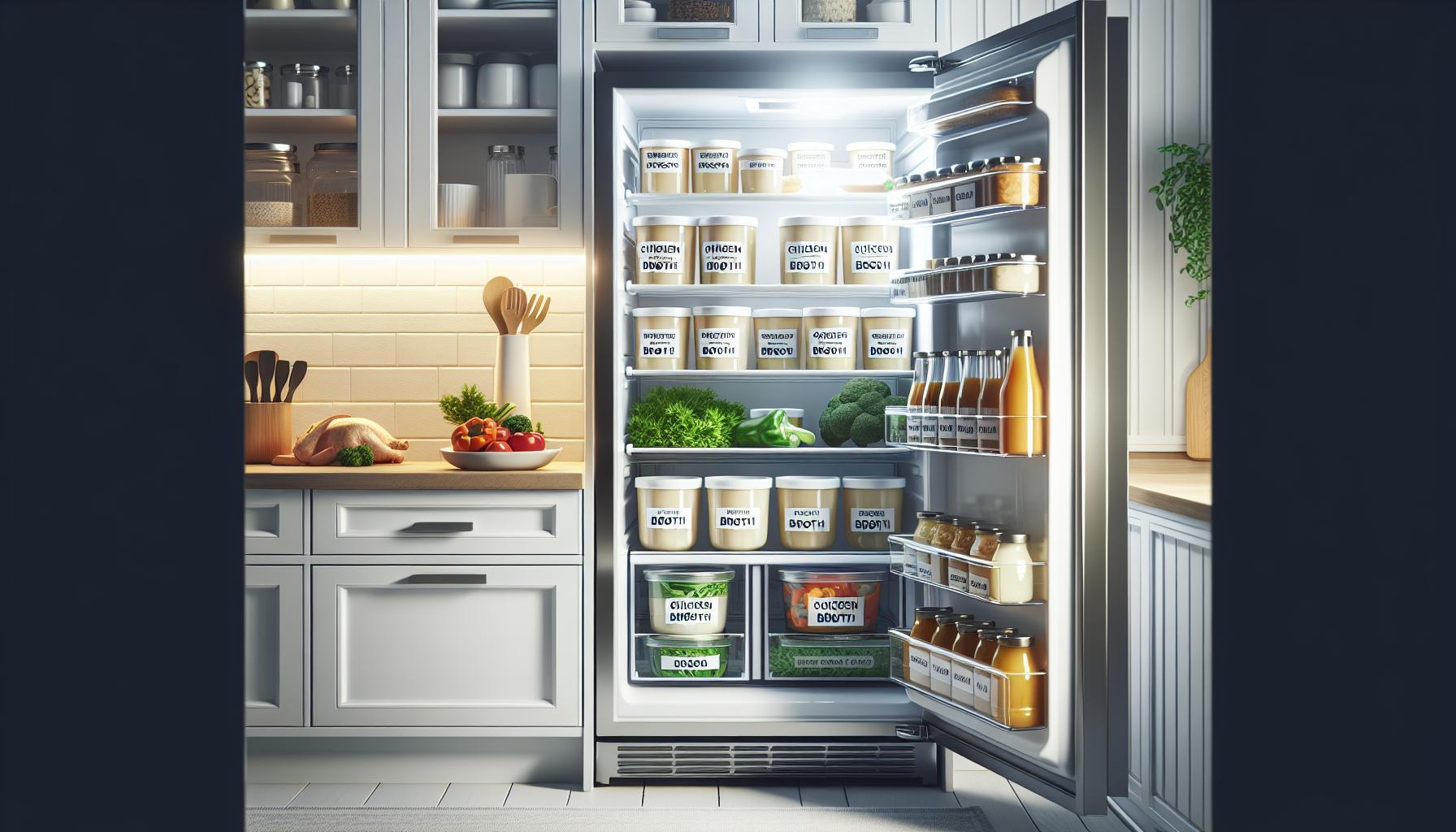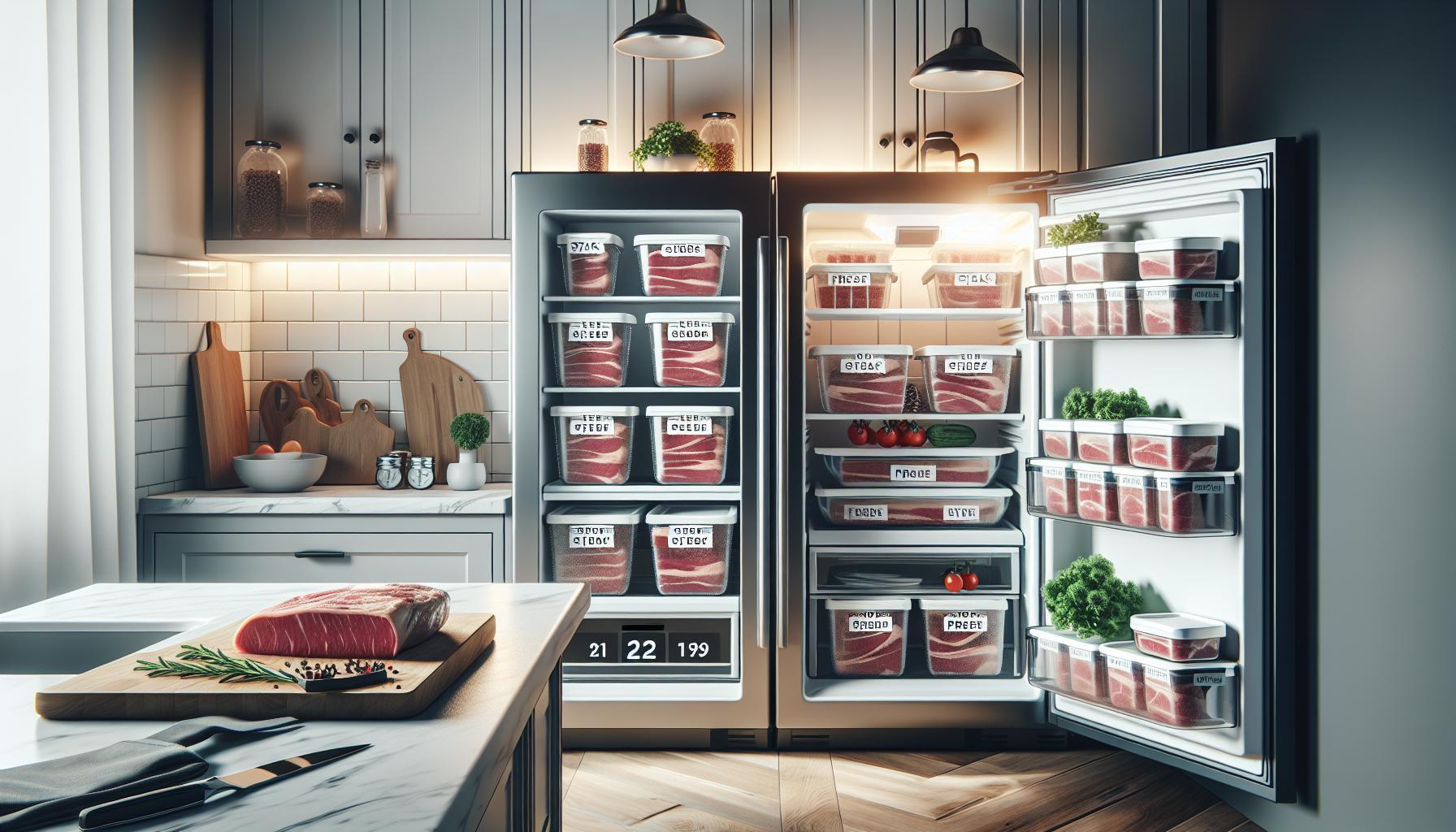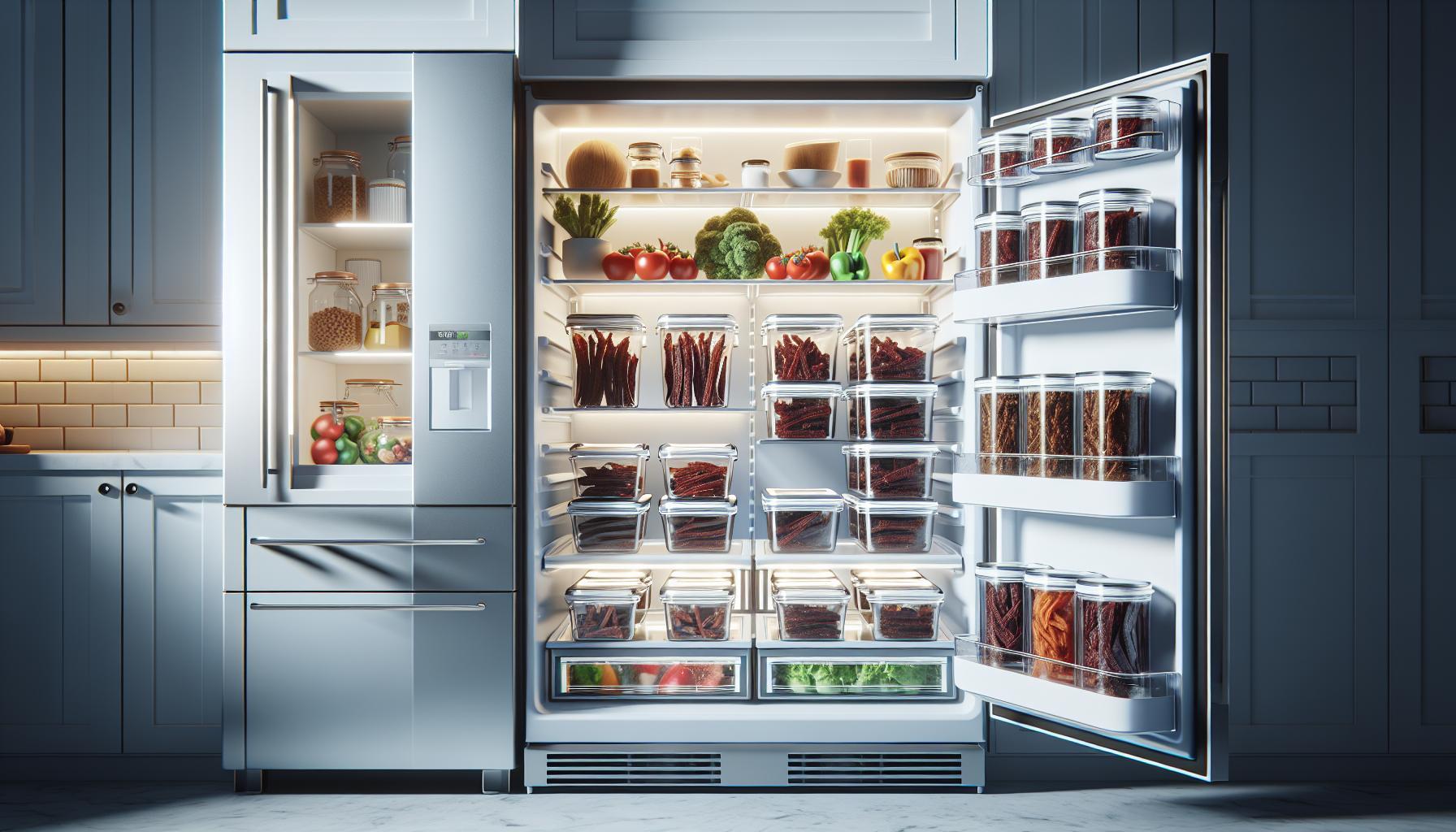Did you know that improper storage can turn your delicious homemade chicken broth into a breeding ground for bacteria? Knowing how long chicken broth lasts in the fridge is crucial for both food safety and meal planning. Whether you’ve just whipped up a big batch or have some leftovers, understanding the shelf life of chicken broth can help you avoid spoilage and ensure your meals remain both healthy and tasty.
Many people enjoy the convenience of having broth on hand for soups, sauces, or as a base for countless recipes. However, it’s essential to keep track of how long it’s safe to keep in the refrigerator. By following specific storage guidelines, you can maximize the freshness of your chicken broth without risking your health. Continue reading to discover key tips on how to store your broth properly and the definitive timeframe for when it should be consumed. Knowing this can save you from unnecessary food waste and ensure you enjoy every drop!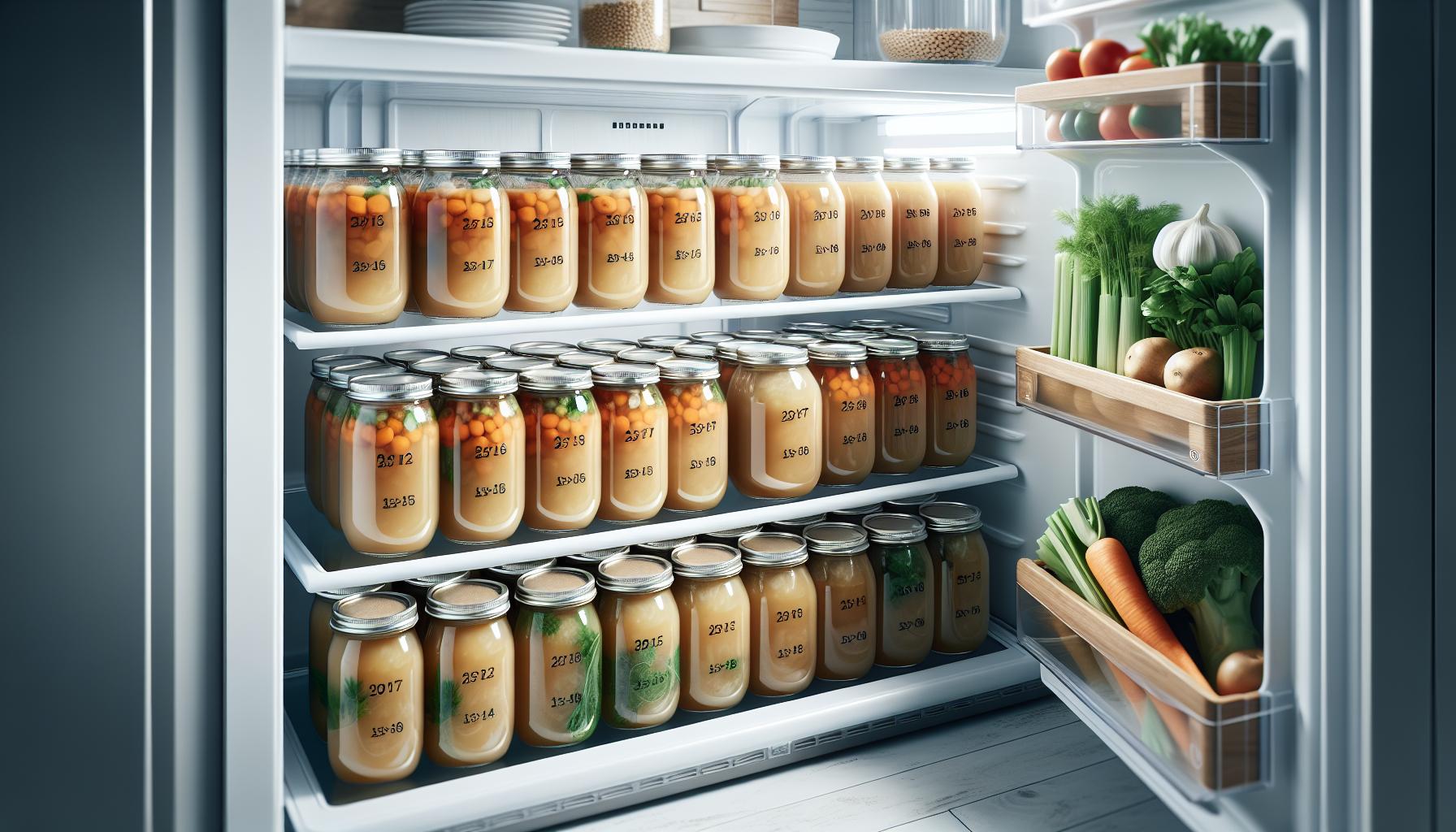
How to Store Chicken Broth Safely in the Fridge
To ensure your chicken broth remains fresh and safe for consumption, proper storage techniques are essential. Storing broth correctly in the refrigerator minimizes the risk of spoilage and helps retain its flavor and nutritional value. When storing chicken broth, it’s crucial to cool it down to room temperature before placing it in the fridge. This can be done by placing the pot in an ice bath or transferring smaller amounts to shallow containers, allowing for quicker cooling.
Once cooled, transfer the broth into airtight containers, leaving some space at the top to account for expansion when frozen. A range of suitable containers includes glass jars, plastic food storage containers, or heavy-duty freezer bags. Make sure to seal them tightly to prevent any odors from permeating and affecting the taste of your broth. Additionally, proper labeling is vital; include the date of storage on each container to keep track of freshness.
When stored in the refrigerator, homemade chicken broth generally lasts for about 3 to 4 days. Store-bought, commercially prepared broth may have a longer shelf life depending on preservatives but should also be consumed within similar time frames once opened. Always store your chicken broth at or below 40°F (4°C) to inhibit bacterial growth. Regularly check your broth for signs of spoilage, such as off odors, discoloration, or mold, and discard any that exhibit these signs to ensure safe consumption.
Understanding Chicken Broth Spoilage Signs
Understanding the signs of spoilage in chicken broth is crucial for ensuring food safety and maintaining the delicious flavor that makes it a staple in many kitchens. Spoilage can occur even under the best storage conditions and can manifest in various ways. To keep your broth safe and tasty, it’s essential to familiarize yourself with the indicators that suggest it may no longer be suitable for consumption.
One of the primary signs to watch for is the development of off odors. Fresh chicken broth has a pleasant, savory aroma, but once spoilage begins, it can emit sour or rancid smells. If your broth starts to smell strange or different from its original scent, it’s a good indication that it has gone bad. Additionally, visual cues such as discoloration or the presence of mold are clear red flags. If you notice a cloudy appearance, particularly in previously clear broth, or any floating particles that were not there before, it’s wise to err on the side of caution and discard the broth.
Texture changes can also signal spoilage. Chicken broth that has thickened excessively or has developed a gelatinous consistency may be more susceptible to bacteria growth. While some broth can thicken as it cools, if it appears unusually viscous or slimy, it’s best to throw it out. Lastly, trust your instincts. If something about the broth seems off even if no apparent spoilage signs are visible, it’s safer to discard it. Always prioritize your health by regularly checking your stored broth and adhering to proper storage practices to extend its shelf life.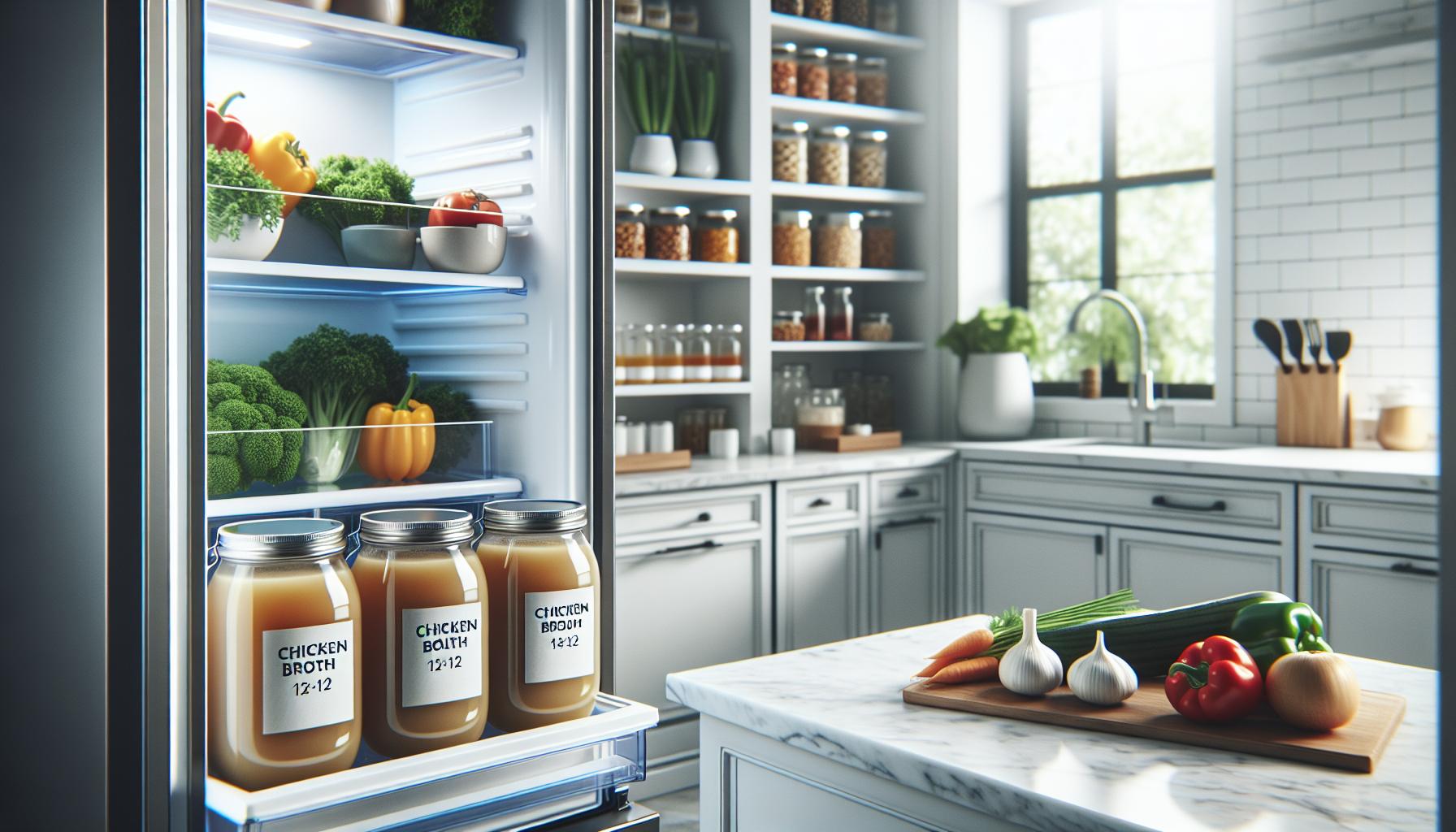
Ideal Shelf Life of Chicken Broth in the Refrigerator
Chicken broth is a versatile kitchen staple, but knowing how long it remains safe to consume when stored in the refrigerator is crucial for both flavor and food safety. Generally, homemade chicken broth can last about 3 to 4 days in the fridge when stored properly. Store-bought broth, if opened, follows a similar rule and should also be consumed within this time frame. To maximize the lifespan of your broth, it’s essential to keep it in an airtight container. This helps prevent exposure to air and other contaminants, reducing the risk of spoilage.
For optimal storage, ensure the broth is cooled before sealing and refrigerating. When broth is stored while still warm, condensation can accumulate inside the container, promoting bacterial growth. It’s best practice to transfer any leftover broth to a clean, sealed container and place it in the fridge as soon as it’s safe to do so.
If you’re ever unsure about the freshness of your broth, remember the adage: “When in doubt, throw it out.” Consuming spoiled chicken broth can lead to foodborne illness, so err on the side of caution if you detect off smells or unusual changes in texture. By adhering to these guidelines, you can enjoy delicious chicken broth while ensuring your meals are safe and healthy.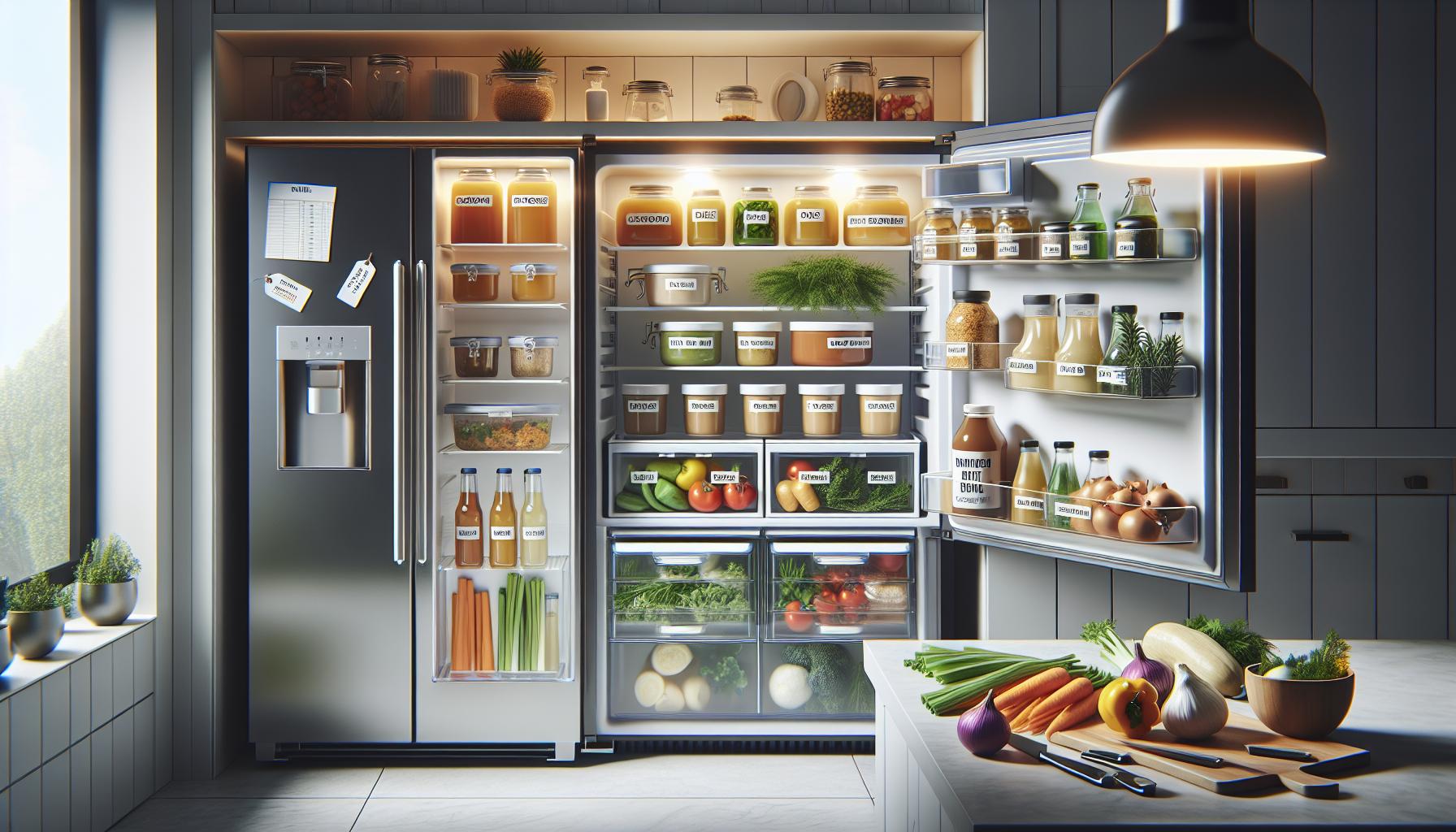
How to Extend the Freshness of Chicken Broth
While chicken broth is a culinary delight that adds depth of flavor to many dishes, extending its freshness can be challenging. To keep your broth as tasty and safe as possible for longer, certain strategies can help.
First, always make sure to cool your broth quickly before storing it; this is critical in preventing bacterial growth. Divide the broth into smaller portions-these smaller containers will cool more quickly than one large batch, which allows you to safely store them in the fridge without promoting spoilage. Consider using shallow, tightly sealed containers so that the broth can cool evenly and mitigate the risk of overheating.
Another effective method for extending the freshness of chicken broth is to utilize ice cube trays. By pouring cooled broth into an ice cube tray and freezing, you’ll create convenient portion sizes that can be used later in recipes. Once frozen, transfer these broth cubes into a resealable plastic bag, removing as much air as possible before sealing. This approach not only saves space but also makes it easy to add an exact amount of broth to your dishes as needed.
When storing, always label your containers with the date to keep track of freshness. If you follow these guidelines, you’ll be able to enjoy your chicken broth well within the ideal shelf life, ensuring both its flavor and safety for weeks to come. Remember, a little foresight in your broth storage can significantly enhance your meal preparation experience while minimizing food waste.
Freezing Chicken Broth: Best Practices
Freezing chicken broth is one of the best ways to extend its shelf life while preserving its flavor. When done correctly, freezing not only prevents spoilage but also maintains the nutritional value of your broth. To ensure that your broth remains fresh and delicious when thawed, it’s crucial to follow specific best practices.
Start by allowing your broth to cool completely before freezing. This is essential to prevent condensation from forming inside the container, which can lead to ice crystals and affect the quality of the broth. Pour the cooled broth into containers, leaving space at the top since liquids expand as they freeze. Use freezer-safe containers made of glass or BPA-free plastic. Alternatively, ice cube trays are a fantastic option for creating portion-sized servings, making it easier to thaw only what you need later. Once the broth is frozen solid, transfer the cubes to a resealable plastic bag, ensuring you remove excess air to help prevent freezer burn.
Label each container or bag with the date it was frozen. Frozen chicken broth maintains its best quality for up to six months, but it will remain safe indefinitely if kept at 0°F (-18°C) or lower. It’s advisable to consume the broth within the recommended time frame for optimal flavor and texture. When you’re ready to use the frozen broth, simply thaw it in the refrigerator overnight or use the defrost setting on your microwave for quicker results. Always reheat the broth to at least 165°F (74°C) before consuming to eliminate any potential bacteria.
By adhering to these best practices, you can enjoy the convenience and flavor of homemade chicken broth without the risk of spoilage, making your cooking experience more enjoyable and efficient.
Can You Reheat Chicken Broth Safely?
To enjoy chicken broth safely after it has been stored in the refrigerator, it’s crucial to know how to reheat it properly. When reheating, the key is to ensure that the broth reaches a safe temperature to eliminate any potential bacteria that may have developed during storage. Aim for a minimum internal temperature of 165°F (74°C). This guideline helps protect you from foodborne illnesses while also enhancing the broth’s flavors.
Start by pouring your desired amount of chilled broth into a saucepan. To reheat evenly, use medium heat and stir occasionally. This will help distribute the heat and prevent any sections from getting too hot and burning while allowing the entire mixture to reach the appropriate temperature. You can also use a microwave to reheat the broth; place it in a microwave-safe container and heat in short intervals-about 1 to 2 minutes at a time-stirring between each interval to ensure uniform warming.
Check the temperature with a food thermometer to be certain it has reached the safe threshold. If you notice any strange smells or changes in texture before heating, it’s wise to err on the side of caution and discard the broth. It’s always better to prioritize safety over potential waste. If the broth has been left out at room temperature for more than two hours, it should also be thrown out, as harmful bacteria can spoil it rapidly.
By following these straightforward reheating methods and guidelines, you can enjoy delicious and safe chicken broth, maximizing its flavor while minimizing any food safety risks.
Homemade vs. Store-Bought Chicken Broth Storage
When it comes to storing chicken broth, understanding the differences between homemade and store-bought varieties is essential for maximizing freshness and ensuring food safety. Homemade chicken broth, crafted from fresh ingredients, tends to have a shorter shelf life than its shelf-stable store-bought counterpart, primarily due to the absence of preservatives. Typically, homemade broth can last about 3 to 4 days in the refrigerator, while commercially prepared broth may remain safe for consumption for up to a week after being opened. Always check label guidelines for exact storage times to ensure safety.
One of the critical factors in preserving broth quality is how it is stored. Homemade broth should be cooled completely before transferring to airtight containers to avoid condensation, which can foster bacterial growth. Consider using individual portion containers so you can pull out only what you need without exposing the entire batch to air each time. Store-bought broth, once opened, should also be kept in its original container if possible, but if it’s been transferred, ensure it’s sealed tightly and kept in the fridge promptly.
To extend the life of both homemade and store-bought varieties, proper freezing is the best practice. Chicken broth can be frozen for several months, retaining its quality well. When freezing, allow the broth to cool and then pour it into freezer-safe bags or containers, leaving enough space for expansion. Be sure to label each container with the date to keep track of how long it has been stored. This way, you can confidently enjoy your broths later without risking spoilage.
Finally, remember that regardless of the type, always inspect broth before use. Look for off smells, discoloration, or any signs of mold. If there’s doubt, it’s better to err on the side of caution and discard the broth. Maintaining these practices can help ensure the delicious and safe enjoyment of chicken broth in your meals.
Common Mistakes That Lead to Spoilage
Improper storage practices can significantly shorten the lifespan of chicken broth, leaving you at risk for spoilage and potential foodborne illness. One of the most common mistakes is failing to cool the broth adequately before refrigerating it. If hot broth is placed directly into the refrigerator, it raises the overall temperature inside, creating an unsafe environment for other perishables. Always allow homemade broth to cool completely, ideally to room temperature, before transferring it to an airtight container for storage.
Using inappropriate containers can also lead to spoilage. Plastic storage containers that are not designed for food safety can leach harmful chemicals or absorb odors, while non-airtight containers allow moisture to accumulate, promoting bacterial growth. It is crucial to utilize airtight, freezer-safe containers or vacuum-sealed bags. Additionally, neglecting to divide broth into smaller portions can be detrimental; larger containers make it tempting to leave the entire batch out while serving, increasing the exposure time to the warmer room temperature.
Another frequent error is ignoring the expiration dates of store-bought broth. Once opened, commercial broth typically lasts only about 4-7 days in the refrigerator. Relying solely on the “best by” date on the packaging can lead you to consume broth that is past its prime, especially if you missed checking for any signs of spoilage. Always inspect the broth for off-smells, color changes, or mold before use.
Lastly, improper labeling is a mistake that many make, which complicates the tracking of how long a broth has been stored. Always label your containers with both the contents and date of storage. This simple step can prevent you from inadvertently using broth that has exceeded its safe shelf life. By avoiding these common pitfalls and adhering to proper food safety practices, you can enjoy your chicken broth while minimizing the risk of spoilage and the associated health concerns.
Can You Use Expired Chicken Broth?
Using expired chicken broth can often feel risky, but understanding the nuances of broth storage and safety can help you make informed decisions. While commercial chicken broth comes with expiration dates to guide consumers, it’s crucial to remember that these dates often reflect peak quality rather than safety. Typically, unopened store-bought chicken broth can last for several months beyond the printed date when stored properly. Once opened, however, it’s advisable to consume it within 4 to 7 days.
When evaluating expired chicken broth, you’ll want to conduct a thorough sensory inspection. Look for any signs of spoilage, such as an off smell, discoloration, or the presence of mold. If the broth appears cloudy or has floating particles, these may indicate bacterial growth, and it’s safest to discard it. Always err on the side of caution; foodborne illnesses can be severe, and it’s not worth compromising your health for a little broth.
If you find yourself with expired homemade chicken broth, the guidelines remain similar. Generally, homemade broth should be consumed within 3 to 4 days when refrigerated. If you’ve accidentally let it sit longer, assess it thoroughly before deciding to use it. If you’re ever uncertain, it’s better to dispose of questionable broth than to risk foodborne illness.
In summary, while using expired chicken broth is sometimes acceptable depending on the storage duration and condition of the broth, it’s crucial to prioritize food safety. Always rely on your senses and best judgment when determining whether it’s safe to use. When in doubt, it’s always wise to choose freshness over potential risk.
Tips for Properly Labeling Your Broth Containers
Proper labeling of broth containers is essential not only for maintaining the quality of your chicken broth but also for ensuring safe consumption. Many people may not realize that even a simple label can prevent foodborne illnesses and spoilage. When you take the time to label your containers clearly and accurately, you can save yourself from potential health risks while maximizing the freshness of your broth. Here are some practical tips to help you effectively label your broth containers.
First and foremost, always include the date that the broth was made or opened. This provides an immediate reference for how long the broth has been stored. For homemade broth, aim to consume it within 3 to 4 days if refrigerated. For store-bought broth, mark the date it was opened, and aim to consume it within 4 to 7 days. Using a permanent marker or a label maker can ensure that the date remains legible over time.
Additionally, consider writing a short note about the broth’s intended use or its contents, especially if you made a flavorful variation. Indicating whether it’s plain broth or has added herbs and spices helps you quickly recall its flavor profile, which can be especially useful for meal planning or when you’re in a hurry. You might also want to note the volume or quantity, especially if you regularly batch-cook and separate servings.
To enhance visibility, use color-coded labels for different types of broth. For instance, a red label could designate spicy broth, while a blue label could indicate a plain, mild broth. This visual cue can make it even easier to identify the contents and expiration dates quickly.
Lastly, don’t forget to follow a first-in, first-out (FIFO) system. Always place the oldest broth containers at the front of your fridge, so they’re the first ones to be used. This practice, combined with clear labeling, helps ensure that nothing gets forgotten in the back of the fridge, reducing the risk of spoilage and enhancing food safety. By taking these simple steps, you can confidently manage your broth storage, ensuring that your meals remain flavorful and safe.
Signs You Should Discard Chicken Broth
When it comes to preserving the quality and safety of chicken broth, it’s essential to be vigilant about potential spoilage signs. Recognizing when it’s time to discard your broth can prevent health risks and ensure you’re serving only the freshest ingredients. One of the most telling indicators is the broth’s smell. If you detect a sour, rancid, or off-putting odor, it’s a clear signal that the broth has spoiled. Fresh chicken broth should have a pleasant, savory aroma; any deviation from this norm warrants immediate disposal.
Another crucial sign to monitor is the appearance. If you notice any strange films or discoloration on the surface, particularly a greasy sheen or an unusual buildup, it’s best to err on the side of caution and throw it away. Additionally, if the broth has been stored in the fridge for longer than the recommended time-typically 3 to 4 days for homemade broth and up to a week for store-bought-it’s no longer safe to consume. The age of broth, combined with visual and olfactory cues, plays a significant role in determining its safety.
Even if your broth looks and smells fine, it’s important to consider any changes in texture. If you observe clumps or a grainy consistency that wasn’t present when you stored it, or if the broth has separated significantly, these are signs it may have gone bad. Lastly, always trust your instincts-if something seems off, it’s best to discard the broth to avoid any potential foodborne illnesses. Keeping these indicators in mind can help you enjoy your chicken broth safely while minimizing waste.
The Importance of Food Safety in Broth Storage
Ensuring the safety of chicken broth during storage is not merely a precaution-it’s a crucial aspect of food health that can significantly affect your well-being. Bacteria thrive in moist environments and can quickly multiply in improperly stored broth, potentially leading to foodborne illnesses. Understanding the practices that safeguard your broth can help maintain its quality and your peace of mind.
To protect your chicken broth from spoilage, it’s essential to cool it promptly after cooking. Allow the broth to reach room temperature before placing it in the refrigerator, ideally within two hours. This practice reduces the risk of bacterial growth. When storing, use airtight containers to limit exposure to air-a key factor in preventing the development of mold and off-flavors. Label your containers with the date of storage to track freshness easily, remembering that homemade broth generally lasts 3 to 4 days in the fridge, while store-bought varieties can be stored for up to a week if unopened.
Moreover, being aware of how to reheat broth can also enhance safety. When reheating, always bring the broth to a rolling boil for at least one minute to ensure that any lurking bacteria are effectively killed. It is crucial never to reheat broth multiple times, as each cycle of cooling and reheating provides a further opportunity for bacteria to proliferate.
By following these guiding principles of food safety, you can enjoy delicious and nutritious chicken broth without compromising your health. Always prioritize these practices-good food safety habits go a long way in preventing spoilage and maintaining the integrity of your meals.
Faq
Q: How can I tell if chicken broth has gone bad?
A: To determine if chicken broth has spoiled, check for off smells, changes in color, or the presence of mold. If the broth has a sour or unpleasant odor, it’s best to discard it. Always trust your senses; when in doubt, throw it out.
Q: Can I use chicken broth after the expiration date?
A: While using chicken broth past its expiration date may be safe if stored properly, it’s crucial to inspect it first. Check for signs of spoilage such as off odors or unusual appearances. If any signs are present, it’s safer to dispose of it.
Q: What is the best way to store homemade chicken broth in the fridge?
A: Store homemade chicken broth in airtight containers to prevent contamination and spoilage. Label the containers with the date made, and consume within 3-4 days for the best quality. For longer storage, consider freezing it instead.
Q: How long can chicken broth sit out before it goes bad?
A: Chicken broth should not be left out at room temperature for more than 2 hours. If it’s warmer than 90°F, the maximum time is 1 hour. Always refrigerate or freeze leftover broth promptly to ensure food safety.
Q: What signs indicate that frozen chicken broth has spoiled?
A: Signs that frozen chicken broth has spoiled include a foul odor when thawed, visible ice crystals, or a change in texture. If the broth looks or smells off after thawing, it’s best to discard it.
Q: Can I reheat chicken broth multiple times?
A: It’s safe to reheat chicken broth, but limit reheating to once if possible. Repeated reheating can compromise quality and safety. Always bring the broth to a rolling boil, and ensure it reaches a safe temperature of 165°F.
Q: Is it safe to store chicken broth in glass containers in the fridge?
A: Yes, glass containers are ideal for storing chicken broth in the fridge. They are non-reactive and won’t leach chemicals. Ensure the containers are airtight to maintain freshness and prevent spoilage.
Q: How can I make chicken broth last longer in the fridge?
A: To extend the freshness of chicken broth in the fridge, cool it quickly after cooking and store in small, airtight containers. Adding a layer of oil on top can also help seal out air and prevent oxidation. For longer storage, consider freezing portions.
The Conclusion
Now that you know how long chicken broth lasts in the fridge and how critical it is to avoid spoilage, it’s time to put that knowledge into action! Always store your broth in airtight containers and try to consume it within 3 to 4 days for optimal freshness. If you have leftovers that won’t be used in time, consider freezing them for future meals. For more tips on food safety, check out our articles on “How to Properly Store Broths” and “Freezing Tips for Soups and Stocks.”
Don’t forget to join our community for more delicious recipes and expert food storage advice! If you have any questions or want to share your own tips, please leave a comment below. Happy cooking, and remember, keeping your kitchen safe and your food fresh is key to enjoying the best meals!

